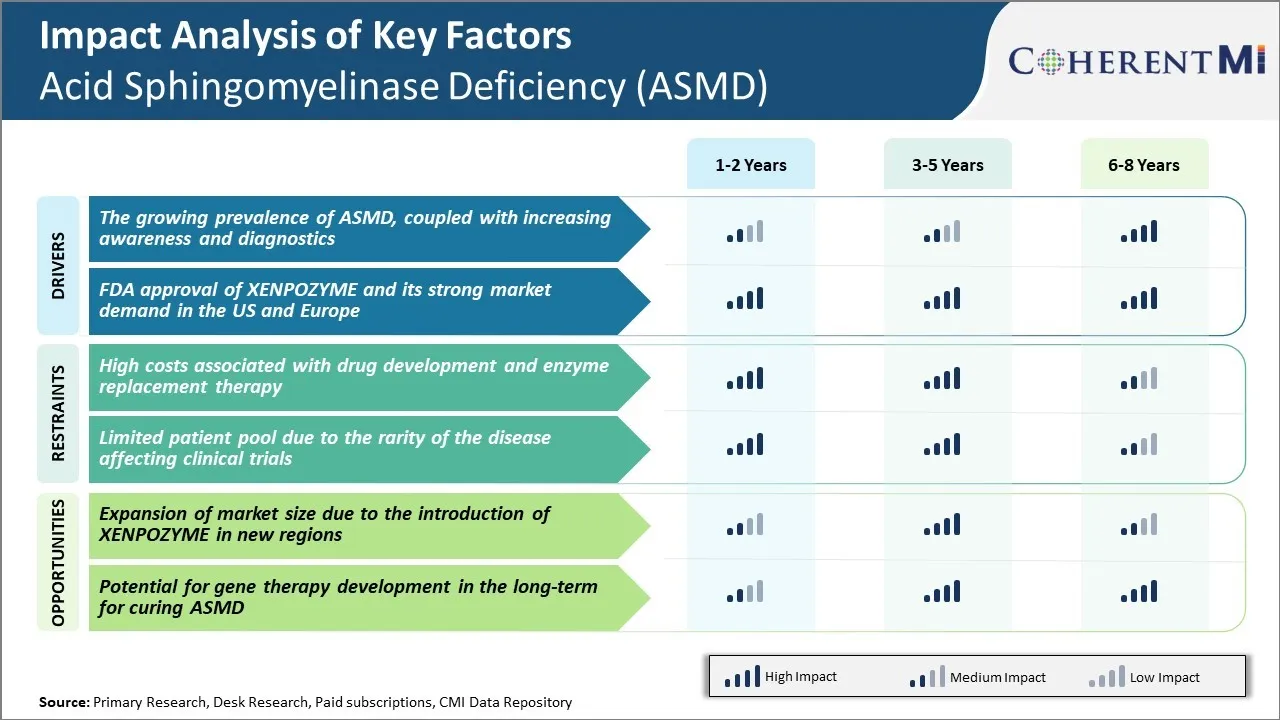缺氧谷氨酸 市场 规模与份额分析 - 成长趋势与预测 (2024 - 2031)
缺氧谷氨酸 市场由治疗(XENPOZYME(olipudase alfa),其他酶替代治疗(ERT)),地理(北美、拉丁美洲、亚太、欧洲、中东和非洲)分割。 本报告为上述各部分提供了价值(百万美元)。....
缺氧谷氨酸 市场 规模
市场规模(美元) Mn
复合年增长率12.1%
| 研究期 | 2024 - 2031 |
| 估计基准年 | 2023 |
| 复合年增长率 | 12.1% |
| 市场集中度 | High |
| 主要参与者 | 萨诺菲, 奥尔法齐姆, 武田药, 兽药 以及其他 |
请告诉我们!
缺氧谷氨酸 市场 分析
硫酸sphingomyelinase(ASMD)市场估计值为: 2024年134.6百万美元 预计将达到 至2031年,300万美元以复合年增长率增长 (CAGR)从2024年到2031年占12.1%. 由于对ASMD的诊断增加,获得酶替代疗法的机会增加,预计市场在预测期间将出现显著增长。
缺氧谷氨酸 市场 趋势
市场驱动力 -- -- ASMD的日益普及,加上提高认识和诊断的不断提高
ASMD是SMPD1基因的突变引起的一种极为罕见的淋巴储存疾病,导致酸性sphingomyelinase酶缺乏. 这种遗传缺陷可以防止Sphingomyelin的正常分解,Sphingomyelin是细胞膜中发现的一种脂肪物质,导致其逐渐累积到有害的水平.
历史上,ASMD被认为是最罕见的淋巴病之一,估计全世界仅有约50到150名已知患者. 然而,新的研究表明,实际流行率可能高于以前所认为的,因为改进的诊断可以准确地查明更多的病例。 此外,人们现在认识到,这种病症既有严重的婴儿病症,也有较轻的晚发病症。
随着ASMD真正流行的焦点更加突出,正在努力提高医疗界和公众对该状况的认识。 患者宣传小组在开展有关征兆、症状和现有检测选择的教育方面发挥重要作用。 诊断传统上依赖入侵性骨髓活体检查,但新的干血点测试使得新生儿能够更方便地筛查和诊断晚发病人。 总体认识的提高,加上比较容易的诊断途径,有助于查明和确认全世界更多的ASMD病例。
市场驱动力-林业发展局批准XENPOZYME及其在美国和欧洲的强劲市场需求
ASMD治疗市场的另一个关键驱动力是FDA最近对XENPOZYME的批准,这是有史以来首次针对这种罕见的遗传紊乱而专门指明的药物. 由萨诺菲公司Genzyme开发,XENPOZYME于2022年1月根据表明其有能力减少细胞中的sphingomyelin积累的数据获得加速批准. 它是一种重新组合的人类酸sphingomyelinase酶替代疗法,每周一次作为IV输液或注射进行,旨在取代缺损或缺失的酶.
对ASMD来说,XENPOZYME是有史以来第一个改变疾病的治疗方案,以前只通过症状护理管理。 临床医生认识到,它有可能有意义地影响这种累进状况经常消失的多系统并发症。 初步真实世界的经验支持临床试验中表现出的正效果和安全性.
以病人和医生调查为重点的市场研究表明,XENPOZYME有可能成为ASMD全球范围的护理治疗标准. 总的来说,这种具有开创性针对性的疗法的可用性预计将成为主要的增长动力,在今后几年中,诊断率不断上升,并刺激了整个酸性sphingomyelinase的市场价值。

市场挑战 -- -- 与药物开发和酶替换有关的高成本 治疗
酸sphingomyelinase(ASMD)市场面临重大挑战,原因是这一罕见疾病的药物研制和酶替代疗法费用高昂。 开发治疗这种罕见病症的药物,需要进行广泛的研究和临床试验,以证明小患者的安全和疗效。 这种药物开发过程对制药公司来说非常昂贵和危险。
此外,称为Cerdelga的核定酶替代疗法的价格每年超过30万美元,使许多保健系统和病人的费用太高。 患者人数少意味着酸性sphingomyelinase(ASMD)市场的整体规模有限,为制药公司弥补药品开发投资提供的收入潜力很小。
酶取代疗法由于其复杂的生物学性质,也产生了高昂的生产成本. 这些重大财政挑战可能阻碍进一步研究新的治疗办法,并限制患者获得ASMD的现有治疗。
市场机会 -- -- 由于在新地区引入XENPOZYME而扩大市场规模
新的ASMD药物XENPOZYME的批准和商业化是扩大这一条件的市场规模的重要机会。 XENPOZYME由Xenetic Biosciences开发,在临床试验中表现出了安全性和有效性.
经监管批准,该公司计划于2023年在美国,欧洲和日本的关键市场推出XENPOZYME. 这将为这些新地区的ASMD患者提供一个重要的额外治疗选择. 引入XENPOZYME还有可能显著扩大整个酸性sphingomyelinase缺乏症市场。
随着XENPOZYME在符合条件的患者中增加吸收,它可以开始抵消Cerdelga目前持有的一些市场. 这一市场扩张将有助于提高为这一罕见疾病人群开发疗法的公司的投资回报率。
处方者偏好 缺氧谷氨酸 市场
酸sphingom yelinase缺乏症(ASMD)是一种罕见的索性存储障碍,其中淋巴酶sphingom yelinase缺乏或缺乏. 处方根据病情的阶段和严重程度,采取分步治疗的方法.
对于没有器官参与的中度和中度病例,患者最初通过支持性护理和症状管理进行管理. 其中包括止痛药、抗生素、物理/职业疗法等。
随着病情的发展,酶取代疗法(ERT)成为标准的一线治疗. 对于婴儿神经轴素ASMD,Cerliponase alfa(Brineura)每隔一周通过输液被定型为细胞内ETR. 这有助于降解中枢神经系统中的sphingomyelin积聚,减缓神经衰减.
对于非神经病形式,处方者更喜欢使用米格卢斯塔特(Zavesca)等药物进行基质减速疗法(SRT). 它通过抑制葡萄糖酰胺合成酶来发挥作用,从而降低底物水平. 扎维斯卡等品牌帮助患者延迟无神经症状的疾病发展.
在严重的后期疾病中,可以考虑肝脏干细胞移植. 然而,鉴于疾病少见和长期结果数据有限,开处方者在建议这种侵入性程序时持谨慎态度。 治疗费用也影响到偏好,因为经证明的神经病的疗效,ERT优于SRT.
治疗方案分析 缺氧谷氨酸 市场
在早期或轻度阶段,提供辅助性管理,以应对出现的个人症状。 可以推荐物理、职业和言语疗法。 提供抗生素是为了防止感染。
对于中度到重度的病例,酶替代疗法(ERT)是标准的一线治疗. 唯一经FDA批准的ERT药物是Alexion的Strensiq(alglucosidase alfa),这是一种通过静脉注射每两周一次的合成人类酸sphingomyelinase酶. Strensiq 减少细胞中的Sphingomyelin积累,改善疾病表现. 它在幼儿期开始时最为有效,可以防止器官损伤的发生。
对于不是ERT候选者或不响应的患者,可以考虑进行骨髓移植. 其目的是通过捐献干细胞来取代有缺陷的基因. 在承担风险的同时,如果成功,则提供永久性的纠正。
正在调查的其他新出现的治疗方法包括基因疗法,利用病毒提供酸sphingomyelinase基因的功能拷贝. 如果证明安全有效,这可以成为一次性治疗方案。 总体来说,治疗主要侧重于早期症状管理,由于治疗在减缓疾病进展方面的效力,将紧急治疗作为标准第一线方法。
关键参与者采用的关键制胜策略 缺氧谷氨酸 市场
林业发展局首次核准治疗的早期市场进入:2017年,Alexion Pharmacels通过获得FDA对Kanuma(sebelipase alfa)的批准,获得了首胜优势,这是ASMD的首个且唯一的批准治疗方法. 这一早期的市场进入使得亚历克西翁在关键的最初几年中通过向患者提供唯一经批准的治疗选择,得以主导市场. 卡努马很快成为了护理的标准,并产生了超过1亿美元的年销量.
治疗机会的急剧商业化和扩大: Alexion在卡努马全球商业化方面投入了大量资金. 它在世界超过25个国家获得了管制批准。 该公司与患者宣传团体密切合作,教育医生,扩大诊断率. 它还提供广泛的病人支助方案,以帮助导航保险和获得挑战。 这些努力帮助卡努马的收入从2018年的3500万美元增长到2021年的1.5亿美元以上,确立了它作为明确的市场领先者的地位.
承诺继续研究与发展新疗法数字 : 为了保持其领导地位,Alexion正在投资进行实验性静脉注射制剂-sebelipase alfa的临床试验,这可能会提供更方便的剂量. 它还支持对ASMD的新基因疗法和其他治疗方式的学术研究。
分段分析 缺氧谷氨酸 市场
透视,通过治疗:XENPOZYME 由于其临床功效和有针对性的行动方式,市场份额巨大
XENPOZYME是专门为酸Sphingomyelinase缺乏症(ASMD)开发的一种酶替代疗法,是一种罕见的危及生命的遗传障碍. 它通过补充患者中存在缺陷或缺陷的酸sphingomyelinase酶水平来发挥作用,从而解决ASMD的根本原因.
在临床试验中,XENPOZYME表明,受ASMD影响的主要器官系统如肝、脾和肺的Sphingomyelin蓄积量大幅减少。 它还表明,在接受治疗的病人中,肺功能参数有所改善。
XENPOZYME有针对性地恢复酸性sphingomyelinase活性,使得它与其他非特定辅助疗法相比,成为ASMD更有效的治疗选择. 它在改善器官功能和症状方面的效力,有助于将其确立为ASMD患者的护理标准. 其他好处,如方便的治疗途径,进一步加强了患者的治疗。
XENPOZYME为管理ASMD的削弱作用提供了强大的临床价值,使其能够主导酸Sphingomyelinase缺乏治疗市场空间,并获得与其他新兴治疗部门相比最高的市场份额。

附加见解 缺氧谷氨酸 市场
- 赤道几内亚 市场影响:XENPOZYME,萨诺菲酶替代疗法,对ASMD的非CNS表现的革命性治疗,特别是在美国,日本和欧洲. 其批准突出表明,在管理罕见疾病时,对此类疗法的需求很大。
- 有限管道 活动:尽管酶替代疗法最近有所进展,但ASMD领域因其罕见且成本高而仍然面临挑战,使得市场上的大量需求得不到满足.
- 美国和欧洲合计占市场份额的90%以上,表明这些地区高度集中。
- ASMD的流行率在美国,欧洲和日本大约为2000名患者,儿科病例占很大比例.
竞争概览 缺氧谷氨酸 市场
在酸sphingomyelinase(ASMD)市场运营的主要玩家包括萨诺菲,Orphazyme,竹田制药,以及Actelion制药.
缺氧谷氨酸 市场 领导者
- 萨诺菲
- 奥尔法齐姆
- 武田药
- 兽药
缺氧谷氨酸 市场 - 竞争对手

缺氧谷氨酸 市场
(主要参与者主导)
(竞争激烈,参与者众多。)
最新发展 缺氧谷氨酸 市场
- 2022年8月,美国FDA批准萨诺菲的XENPOZYME(olipudase alfa)作为第一种酶替代疗法,专门用于治疗酸Sphingomyelinase缺乏症(ASMD)的非CNS(非中枢神经系统)表现,也被称为Niemann-Pick疾病A型和B型. 这一批准是解决影响身体分解某些脂肪能力的罕见遗传障碍的一个重要步骤。 林业发展局批准了XENPOZYME " 突破治疗 " 和 " 优先审查 " 的指定,强调其有潜力大幅度改善病人的结果。
- 2022年3月,XENPOZYME(olipudase alfa)在SAKIGAKE的命名下获得了日本的首次全球批准. XENPOZYME被用于治疗酸性sphingomyelinase缺乏症(ASMD),这是一种罕见的遗传障碍,SAKIGAKE的命名是日本创新药物的快速批准途径.
- 2022年6月,欧盟委员会(EC)批准XENPOZYME(olipudase alfa),一种治疗非中枢神经系统表现的酸性Sphingomyelinase缺乏症(ASMD)的治疗方法,也称为Niemann-Pick疾病A型和B型. 这项批准使XENPOZYME能够在欧洲联盟和欧洲经济区内销售。
缺氧谷氨酸 市场 细分
- 通过治疗
- X(olipudase alfa)
- 其他酶替代疗法

您想要了解购买选项吗?本报告的各个部分?
常见问题 :
酸sphingomyelinase(ASMD)市场有多大?
酸sphingomyelinase(ASMD)市场估计价值134.6美元。 Mn在2024年,预计到2031年将达到300Mn.
哪些关键因素阻碍了酸性sphingomyelinase(ASMD)市场的增长?
由于影响临床试验的疾病很少,药物研发和酶替代疗法的相关费用高昂,病人的聚集也有限,这些是阻碍酸sphingomyelinase(ASMD)市场增长的主要因素。
推动酸性sphingomyelinase市场增长的主要因素是什么?
ASMD的日益普及,加上对XENPOZYME的认识和诊断以及FDA对XENPOZYME的认可及其在美国和欧洲的强劲市场需求,是造成酸性sphingomyelinase(ASMD)市场缺乏的主要因素。
在酸性sphingomyelinase(ASMD)市场中,哪一种疗法是领先的?
主要的治疗部分是XENPOZYME(olipudase alfa).
哪些主要角色在酸性sphingomyelinase(ASMD)市场运作?
萨诺菲,奥尔法齐姆,竹田制药,以及Actelion制药都是主要球员.
酸性sphingomyelinase缺乏症市场的CAGR将是什么?
2024-2031年,酸性sphingomyelinase缺乏症(ASMD)市场的CAGR预计为12.1%。